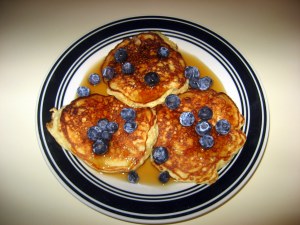
A few weeks ago after a brunch I hosted for friends I found myself with a gallon of 2% milk left over and a few cups of spare buttermilk. That gave me the opportunity to make my own ricotta cheese, which, though it may seem intimidating, really is easier than it sounds. Armed with a recipe from the Smitten Kitchen and some makeshift cheesecloth, I made a double batch of ricotta cheese that was far tastier than anything I’ve bought at the store.

Of course, this left me with a whole lot of ricotta to use up. The recipes I’ve included below made good use of it. You can also use the ricotta in a classic Italian lasagna or in baked goods like muffins.

Homemade Ricotta Cheese
Adapted from Smitten Kitchen, who adapted it from Michael Chiarello
- 2 quarts whole milk (though I subbed 2% milk without any problems)
- 2 cups buttermilk
- 1 tsp kosher salt
- Juice of 1/2 lemon
Line a wide sieve or colander with cheesecloth, folded so that it is at least four layers thick (I didn’t have cheesecloth, so I used two layers cut from an old, clean T-shirt; worked like a charm). Place colander in sink.
Pour milk and buttermilk into a wide, heavy-bottomed pot. Add salt and lemon juice. Cook over high heat, stirring frequently; scrape bottom of pot occasionally to prevent scorching. As milk heats, curds will begin to rise and clump on the surface. Once steam starts to rise off the mixture, stop stirring.
When mixture reaches 175 to 180 degrees, curds and whey will separate (whey will look like cloudy water underneath a mass of thick white curds). Immediately turn off the heat and gently ladle curds into the cloth-lined colander. When all curds are in the colander and dripping has slowed (about 5 minutes), gently gather edges of cloth and twist to bring curds together; do not squeeze. Let drain 15 minutes more. Discard the whey.
Untwist the cloth and pack ricotta into airtight containers. Refrigerate and use within one week.
Yield: about two cups. Can be doubled easily.
Roasted Ricotta Roma Tomatoes
Adapted from The Pioneer Woman
- 8 roma tomatoes
- 1 cup ricotta cheese
- 1/2 cup fresh parsley, minced
- 1/2 cup fresh basil leaves, minced
- 2-3 cloves garlic, minced
- Kosher salt and ground black pepper to taste
- 1/2-3/4 cup panko
- Olive oil for drizzling
Preheat oven to 400 degrees. Halve tomatoes lengthwise. Scoop the insides out of each tomato half and discard. Sprinkle the inside of each tomato half with a bit of kosher salt to help draw out excess moisture and set over a paper towel to drain for 10-15 minutes. Pat dry with a paper towel.
Mix ricotta cheese, herbs, and garlic and season to taste with salt and pepper. Fill each tomato half with a spoonful of the ricotta mixture. Put each tomato half face down in the panko crumbs to coat the cheese and then place face up on a baking sheet. Drizzle each tomato half with a bit of olive oil. Roast in the preheated oven for 25-30 minutes, until the panko is golden-brown on top.
Yield: about 8 appetizer servings.
No-Bake Blueberry Cheesecake Bars
Adapted from the New York Times
- 8 whole graham crackers, crushed into crumbs
- 3-4 tablespoons melted butter
- 1 8-ounce package cream cheese, softened
- 1 cup ricotta cheese
- 2 tablespoons honey
- Zest of 1 lemon
- Pinch salt
- 1 1/2 cups blueberries
Combine crushed graham crackers with enough melted butter so that the mixture easily presses together between your fingers. Press evenly into bottom of a glass 8- or 9-inch square pan to form a crust about 1/4-inch thick. Refrigerate while you make the cheesecake layer.
Using a standing or hand mixer, or a whisk, combine cream cheese, ricotta, honey, lemon zest and salt, and blend until smooth. Spread cheese mixture carefully and evenly over crust, smoothing top with a spatula. Cover with fresh blueberries and press them lightly into the cheesecake layer. Chill for at least an hour, or until set. Cut into squares or bars and serve.
Yield: 8 to 12 servings
Lemon Ricotta Pancakes
Adapted from Bobby Flay
- 3/4 cup all-purpose flour
- 1 tablespoon baking powder
- 1/2 teaspoon ground nutmeg
- 1/4 teaspoon salt
- 2 tablespoons sugar
- 1 cup ricotta cheese
- 2 eggs
- 2/3 cup milk
- Juice and zest of 1 lemon
- Butter, for griddle
- Syrup and fresh berries, for serving
Preheat a non-stick griddle. Combine dry ingredients in a small bowl. Whisk together the cheese, eggs, milk, and lemon zest and juice in a large bowl. Fold the flour mixture into the wet ingredients until just combined, being careful not to overmix. Brush the hot griddle with butter. For each pancake, pour approximately 1/4 cup of the batter on the griddle and cook on both sides until light golden brown. Repeat until no batter remains. Serve with syrup and fresh fruit, such as strawberries, raspberries, or blueberries.
Yield: about 4-6 pancakes









